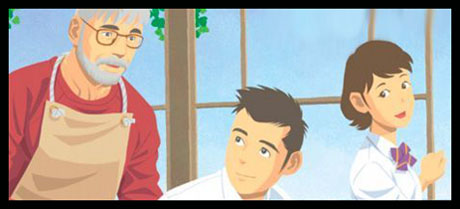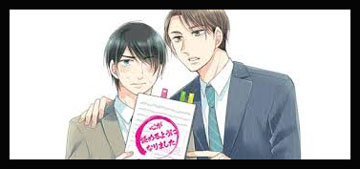
EDITOR’S NOTE: This week the Annecy International Animation Festival commences – and in support of their spotlight on Animation, Pride and Diversity, we asked our anime expert Charles Solomon to suggest some recent gay manga (and anime) we should be more aware of.
As the recent summit in Hiroshima spotlighted, Japan is the only G7 country that does not recognize same-sex marriage. Although a poll conducted earlier this year by the Asahi Shinbun news organization showed 72% of voters favored legalization, Prime Minister Hirohide Ishida’s conservative (despite its name) Liberal Democratic Party opposes it. Yet Japanese artists are producing some interesting depictions of gay men–as several recent manga and their animated and live action adaptations demonstrate.

My Brother’s Husband, by Gengoroh Tagame
Many gay characters appear in Boy’s Love or “BL” manga, animated films and novelizations. This curious genre first appeared about 45 years ago and has grown steadily in popularity, spreading to the US, Thailand and South Korea. Also referred to as yaoi or shounen-ai, BL depicts romances between beautiful young men with long legs, large eyes and cascading points of hair. But the stories are created by women for female audiences.
Most BL romances follow familiar patterns. There are tales about crushes between tall high school senpai (upper classman) and cute kohai (lower classman). The teen-agers bond over manga, music, video games and movies. Special assignments, overtime and after-hours office drinking parties offer 20-something professionals with opportunities for sparks to fly. Stories involving adults often move from the office to never-never lands of penthouse boudoirs and romantic destinations. In Dakaishi: I’m Being Harassed by the Sexiest Man of the Year (2018), rising actor Junta lives in a spacious apartment in Tokyo that Crown Prince Fumihito would have trouble affording.
Gay men in Japan generally ignore BL stories, preferring different, often explicit manga. But in recent years, some of the BL fantasies have begun including believable characters in credible relationships, and gay artists have started reaching out to a wider public.
Gengoroh Tagame is best known for his dark homoerotic fantasy manga. But he received international attention for “My Brother’s Husband” (2014), his first work for mainstream audiences, winning prizes in Japan and an Eisner Award in the US. A divorced father in suburban Tokyo, Yaichi Origuchi manages an apartment building and takes care of his precocious daughter Kana.
The arrival of outgoing, ursine Mike Flanagan, the Canadian widower of Yaichi’s estranged twin Ryoji, forces Yaichi to reexamine his relationship with his brother and his attitude toward homosexuality. How should he have treated Ryoji when he came out? How could he protect Kana from disapproval and discrimination is she chose a same-sex partner? Yaichi eventually accepts Mike as a member of the family, inviting him to offer incense to their ancestors at the family tomb. A TV mini-series of “My Brother’s Husband” preserves the essential charm of the story.

“Our Colors”
Tagame followed “My Brother’s Husband” with “Our Colors” (2022), a manga centered on Sora, a talented 16-year-old artist. The colors Sora sees in the sky and sea echo the paints he uses and vice versa. As his mood shifts, so do the colors he perceives. Tagame captures the angst that wracks any teen-ager who feels outside the norm. At school, Sora pretends he’s attracted to female pop stars. He doesn’t dare mention–let alone act on–his crush on his athletic buddy Yoshioka.
Sora finds an unexpected friend in Mr. Amamiya, a gay man who runs a beachside café. He encourages the teen-ager not to be ashamed of being gay, but to carefully consider how he reveals his sexuality and to whom. When Sora comes out to his parents, his mother tries too hard to be both funny and supportive. Sora storms into his room, grumbling, “I don’t need understanding. Just acceptance. That’s all I want.” It’s easy to imagine the over-supported Ethan Clade in Disney’s Strange World giving the same speech.
In his afterword, Tagame notes that as a teenager, he had no lover or gay friends and no positive media images of gay people: “This is for the that 15-year-old 42 years ago.” Many gay teen-agers will see themselves in this manga, and find comfort in reading and re-reading it. Unfortunately, no plans have been announced for a film or TV series of “Our Colors.”
Many BL characters either see themselves as heterosexual, or they’re inexperienced neophytes who don’t seem to have given their sexuality much thought. The standard response to the unexpected same-sex declaration of affection tends to be a mixture of wistful longing and bemusement: “Gee, I finally fall for someone/ someone finally falls for me–and it turns out to be a guy.” In contrast, Shou Harusono’s “Sasaki and Miyano” manga and the animated series based on it, and Kaito’s “Blue Flag” manga focus on self-examination, decision making and empowerment.
Sasaki and Miyano are a classic senpai/kohai pair at an all-boys’ high school. Sasaki is a second year student whose dyed hair and piercings mark him as a Bad Boy. Quiet, studious first year Miyano is always being teased about being cute. When Sasaki asks him to go out (a very serious commitment in Japan), he doesn’t know how to respond. Miyano admires Sasaki’s cool demeanor and likes the gentle guy underneath the rough exterior. But does he return Sasaki’s romantic feelings? He keeps pondering the question, “What does it mean to love someone?”
The Japanese verb suki de aru can be translated as “like” or “love” depending on the context, which sometimes muddies the anime subtitles. When Miyano dozes on the train, his head resting on his senpai’s shoulder, Sasaki isn’t saying “I like you” when he whispers to him.
After months of reflection, Miyano concludes that if his feelings for Sasaki “aren’t the real deal, what is?” Like Simon and Bram in Love, Simon, Sasaki and Miyano find themselves together and happy. The animated series preserves the look of Harusono’s designs, but keeps the focus on the main characters (the manga sometimes wanders off into side stories). A Sasaki and Miyano feature will be released later this year.

“Blue Flag”
Complex characters and fine draftsmanship set Kaito’s “Blue Flag” (2017) apart: It was a finalist for the LA Times Book Prize for Graphic Novel. The first seven books chronicle romantic contretemps at Aohama High School. Brooding, morose Taichi is surprised to find himself attracted to Futaba, a shy girl who continually apologizes for her mistakes—even when she hasn’t made any. She had a crush on Taichi’s best friend Toma, the handsome, popular star of the baseball team. Toma has secretly been in love with Taichi for years. The reader can see the mixed affection and longing when Kaito draws Toma gazing at Taichi.
“Blue Flag” focusses on the choices high school seniors face: What to study, what colleges to apply to, whom to befriend, whom to date. It’s a difficult time to navigate. The characters cope with worry, excitement and uncertainty—complicated by the Taichi-Futaba-Toma triangle. Kaito moves the story in a surprising direction in the “Final Chapter” in Volume #8. Set seven years later, it’s told from Toma’s point of view: The drawings are what he sees as he observes his former classmates living with the choices they made.
Toma attends Futaba’s wedding, then meets Taichi at the station. He sums up the manga when he reflects: “Life is a never-ending series of choices. Even when you try to make the best choices you can…you might hurt someone. You might hurt yourself…Conversely, one choice might go so well…and you might find happiness so precious to you…that you fear making the next choice that faces you.” Blushing happily, Taichi takes his lover’s hand and says, “Let’s go home.”
Posts on numerous fan sites complain that “Blue Flag” hasn’t been animated. Kaito’s polished drawings would be a challenge to animate, but the work’s high quality and ongoing popularity warrant a film or series.

“Cherry Magic! Thirty Years of Virginity Can Make You a Wizard?!”
Yuu Toyota came up with a clever gimmick and two interesting characters in “Cherry Magic! Thirty Years of Virginity Can Make You a Wizard?!” (2018). According to her urban legend, a person who’s still a virgin on their 30th birthday acquires the magical power to hear the thoughts of anyone they’re touching. In the manga, live action TV series (2020) and feature (2022), Kiyoshi Adachi discovers it’s true.
A hard-working, kind-hearted, put-upon salaryman in an office supplies firm, Adachi is devoid of self-confidence. He’s never been on a date, never kissed anyone, never even gotten obligatory chocolate on Valentine’s Day. When he’s shoved up against Yuichi Kurosawa in the elevator, he discovers the company’s suave star salesman is in love with him. He also learns how frustrated Kurosawa is at being judged solely on his good looks. He strives for perfection to prove he’s not just a handsome nonentity. Kurosawa’s earnest courtship of Adachi seesaws between comic and touching.
The TV series improves on the manga. Toyota indulges in some overblown BL fantasies: Kurosawa hires a helicopter to fly them over Tokyo for their first date and Adachi gets airsick. The filmmakers move the story from Xanadu to everyday Tokyo, which makes their misadventures more credible. Kurosawa takes Adachi to a small amusement park, where he gets sick on one of the rides. In the manga, Kurosawa sometimes schemes and Adachi natters: The televised characters are more sympathetic and engaging. The TV writers also sort out the storyline: Toyota jumps between the present and flashbacks.
Eiji Akaso brings deft comic timing to Adachi’s befuddled insecurities and a believable strength to the conviction he develops. Keita Machida won acting awards in Japan for both the TV series and the film: His understated Kurosawa embodies professional charm, fretful anxiety and gentle affection.
The “Cherry Magic” feature moves the story in a more serious direction than the manga or the TV series, highlighting the discrimination LGBTQ+ people face in Japan. Adachi and Kurosawa violate societal norms by moving in together, but the arrangement enables them to flourish. With Kurosawa’s encouragement, Adachi grows confident and capable; Kurosawa realizes he doesn’t have to be perfect: Adachi loves him as he is.
But they face social and legal obstacles that never troubled Mike and Ryoji in “My Brother’s Husband”—or most BL couples. When Kurosawa tells Adachi their boss is impressed with his recent work, he replies, “I want to be essential at work–so we won’t be separated unfairly if our company finds out about us.” Although it won’t alter their legal status, they decide to marry, which requires formally requesting their parents’ permission. Adachi’s boisterous family enthusiastically welcomes Kurosawa. But Kurosawa’s elegant mother asks if they can be absolutely certain they’ll never regret such unconventional behavior. The once timid Adachi replies, ”I’m absolutely certain of only one thing: I love Kurosawa.”
The “Blue Flag” manga and the “Cherry Magic” feature end with similar images: Two men walking home through Tokyo holding hands–a small gesture of affection that becomes a brave call for recognition and equality.
Blue Flag (Viz Media: $12.99, eight volumes)
Cherry Magic! Thirty Years of Virginity Can Make You a Wizard?! (Square Enix Manga: $14.99; six volumes translated.)
My Brother’s Husband (Pantheon: $24.95, two volumes)
Our Colors (Pantheon: $20.99)
Sasaki and Miyano (Yen Press: $11.70, eight volumes translated)
Cherry Magic! Thirty Years of Virginity Can Make You a Wizard?! (live action series, on Crunchyroll)
Cherry Magic! Thirty Years of Virginity Can Make You a Wizard?! (live action feature on DVD)
My Brother’s Husband (on DVD)
Sasaki and Miyano (on Crunchyroll)
- Charles Solomon’s Animation Year End Review 2023 - December 28, 2023
- INTERVIEW: Makoto Shinkai on “Suzume” - November 27, 2023
- Interesting Portrayals of Gay Men in Manga/Anime - June 12, 2023


 June 12th, 2023
June 12th, 2023  Charles Solomon
Charles Solomon  Posted in
Posted in  Tags:
Tags: 






